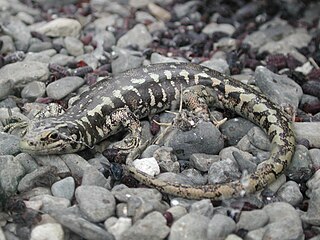
Oligosoma is a genus of small to medium-sized skinks found only in New Zealand, Norfolk Island and Lord Howe Island. Oligosoma had previously been found to belong to the Eugongylus group of genera in the subfamily Lygosominae; the Australian genus Bassiana appears to be fairly closely related.

The Otago skink is a rare, endangered species of large skink in the family Scincidae, found in the rocky canyons and grassy patches of Central Otago, New Zealand.

Zealandia, formerly known as the Karori Wildlife Sanctuary, is a protected natural area in Wellington, New Zealand, the first urban completely fenced ecosanctuary, where the biodiversity of 225 ha of forest is being restored. The sanctuary was previously part of the water catchment area for Wellington, between Wrights Hill and the Brooklyn wind turbine on Polhill.

The grand skink is an endangered species of large skink endemic to the central Otago region of New Zealand.

Falla's skink, also known commonly as the Three Kings skink, is a species of lizard in the family Scincidae. The species is native to New Zealand.
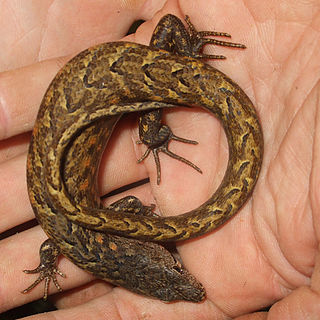
The chevron skink, is a large species of skink endemic to New Zealand, found only on Great and Little Barrier islands in the Hauraki Gulf. A cryptic forest dweller, it can hide underwater, and is under threat from introduced rats.

Oligosoma infrapunctatum, the speckled skink, is a species of skink in the family Scincidae. It is endemic to New Zealand.
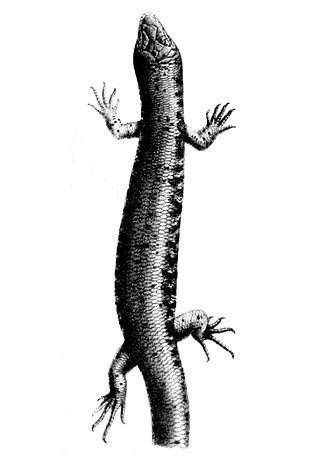
Oligosoma suteri, known commonly as Suter's skink, the black shore skink, the egg-laying skink, and Suter's ground skink, is a species of lizard in the family Scincidae. The species is endemic to New Zealand.
Oligosoma taumakae, the Open Bay Island(s) skink, or Taumaka skink, is a species of skink. It was described from the Open Bay Islands, off the west coast of the South Island of New Zealand.
Hardy's skink is a species of skink, a lizard in the family Scincidae. The species is endemic to the Poor Knights Islands of New Zealand.

The Barrier skink is a species of medium-sized skink, a lizard in the family Scincidae. The species is endemic to New Zealand, where it lives in the alpine habitat of the Darran and Takitimu Mountains of Fiordland. It is one of only two species of New Zealand skinks that live exclusively in the alpine zone, the other being the "Sinbad skink", Oligosoma pikitanga, a closely related species of similar appearance which is found in the same part of the South Island. The Barrier skink was first collected in the 1960s but was overlooked until rediscovery by a pair of mountain climbers in 2005; the species was scientifically described in 2009.
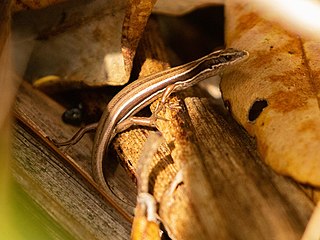
The moko skink is a species of lizard in the family Scincidae (skinks) that is endemic to New Zealand. Moko is the Māori word for lizards in general.

Anthony Hume Whitaker was a New Zealand herpetologist, contributing a 50-year career of fieldwork, pioneering research and species discoveries. His is still the largest collection of reptile and amphibian specimens donated to Museum of New Zealand Te Papa Tongarewa.

The Burgan skink is a nationally endangered species of skink native to New Zealand. It was described from a specimen found near the Burgan Stream, in the Rock and Pillar Range, Central Otago.

The cryptic skink is a nationally vulnerable species of skink native to New Zealand.

The spotted skink is a nationally at risk species of skink native to New Zealand. The Spotted skink is currently known to be present in the Hawkes Bay, Wairarapa and Wellington regions as well as in Nelson, Marlborough and Canterbury. It is also present on Somes Island, Mākaro / Ward Island, North Brother Island and Stephens Island. Adult males and adult females of the species significantly differ in the snout-vent length with body sizes reaching 111mm. Females produce around 3 - 4 young.
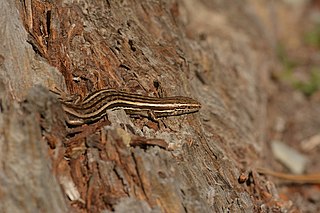
The McCann's skink is a species of skink native to New Zealand.

The common skink, also known as the northern grass skink, is a species of skink native to New Zealand. Although historically classified as a subspecies of Oligosoma nigriplantare, it is likely to be given separate species status as data suggests it is a distinct species.

The brown skink is a species of skink native to New Zealand.

The Chesterfield or Kapitia skink is a species of skink found in New Zealand. Only discovered in 1994 and for years not recognised as a distinct species, it is endemic to a narrow 1 km strip of coastal vegetation on the West Coast of New Zealand, 15 km north of Hokitika. There are fewer than 200 individuals remaining in the wild. Oligosoma salmo is the only New Zealand skink with a prehensile tail, suggesting it was once arboreal and inhabited coastal forest, which was subsequently cleared for dairy farming. Following the partial destruction of its remaining habitat in 2018 by a cyclone, a small captive breeding population was established at Auckland Zoo.

















